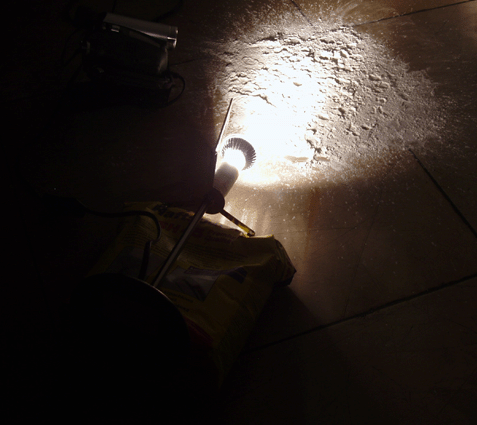Back into the Future of Video Art
Alexander Steig’s Mental ImagesIn the visual overkill of our information society, it is precisely calm media images that cast the most lasting spell. And the viewer pauses for a small eternity in front of Alexander Steig’s projections due to the unspectacular and often unstoried reappearance of deceptively familiar motifs and aesthetic phenomena. The “spectacle” ultimately lies—a prima vista—in the obscure origins of the transmitted images. Take, for instance, the projection in which a celestial body shifts into focus and over whose crusted surface of craters the sun appears to be setting. At the edge of its spot-lit, slightly curved horizon, we see a star sinking into dark space. What else could this projected image on the blank wall be than a satellite picture of the moon or some other uninhabited planet? Yet, something is not quite right with the illusionistic rendering of the planetary phenomena. And as we begin to scan the image’s surface and entire compositional field, detective-like, certain clues emerge. The structure of the planet’s surface, which at first appears to be the result of a solidified lava flow, now seems a bit too synthetic and varnished. The solar light source blazes more like a shooting star in free fall. And the would-be sun continues to remain at a constant level despite its low-lying position. It’s a nice, long moment of surprise when we finally discover the actual physical conditions of Alexander Steig’s simulated views, particularly since the camera settings and close-up details created by the wide-angle lens lead us to believe that the extraterrestrial reality exists. But in the case of sunset (2006), it is de facto a rather unevenly plastered wall that Alexander Steig has partially illuminated with a spotlight—in order to tease out its brightened perceptual field from the dark, using a precisely positioned camera, to then reflect it elsewhere on the same wall via a video projector.

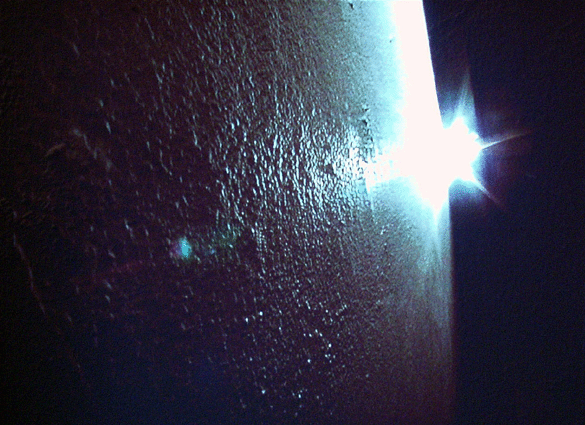
sunset, 2007, Kunsthalle FAUST, HannoverFor his City of Munich project grant, Alexander Steig had to scout out a “darkroom” suitable for his deceptive media maneuvers. Especially since his subtly dosed interventions—such as those employing the closed-circuit video surveillance we know from public space—are best shown in the somewhat unglamorous shadowy existence of an off-space that is not necessarily an official exhibition venue. Thus, it is in a former heat and power plant in Munich’s Müllerstraße, an ideal exhibition space, that three pieces are presented in parallel for the first time in a kind of dramaturgical scenario entitled make some space.
In addition to the “sunset” just described, also on view is Space #2 (stars) (2005), another stellar adventure via media transfer into a star-studded sky, whose realistic group of stars clustered around one shining fixed star would probably only be possible with a clear view of the nocturnal horizon from the South.
1.gif)
Space #2 (stars), 2005, Arena, BerlinHere, too, the solution to the optical riddle is all the more astonishing. Steig uses his video camera (this time positioned on the ground) like a telescope to peer through a perforated cardboard box illuminated from behind. In so doing, he demonstrates a physical perceptual experiment: the conscious denial of real space in favor of the reproduction of a galactic event on the monitor of a black-and-white television set. In Flying, the third part of this excursion into a fabricated universe and a remake of Steig’s installation of the same name from 2000, we see—last but not least—a flying object gliding over a sandy desert landscape. To be more precise, it is a theatrically illuminated paper airplane circling over a dust-covered turntable, its silhouette incessantly observed by video camera and projected onto a monitor as if to control its course.
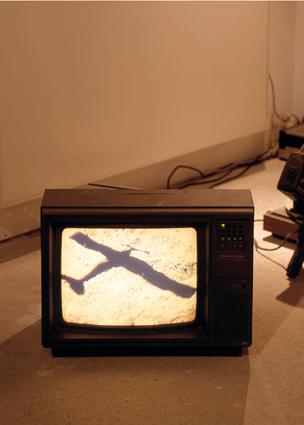
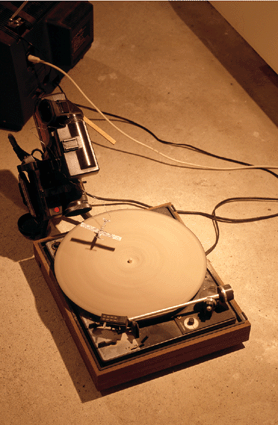
flying, 2000, Eine Deutsche Einkaufspassage, Hannover; flying, 2003, Gallery of the City of BremenWhat is impressive about Steig’s pseudo-scientific experimental arrangements is the light-handedness of their construction. His spatial interventions are by their very nature fleeting and can only be perceived authentically when viewed “live” at the location specifically designated for them. If these constructions are dissembled into their individual components at the end of their given playing time, nothing more than a video camera, spotlight, banal everyday object and image carrier remain as constants of the media equation. In this respect, Steig’s installations have something in common with the development of new theatrical plays and, just like in a dress rehearsal or debut performance, the direction, lighting and props must be negotiated into the correct position depending on the particular content.
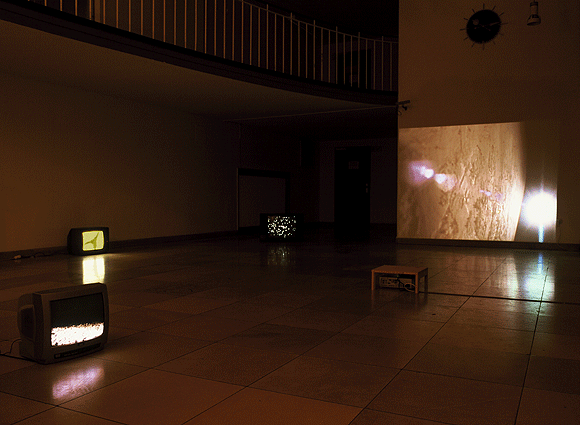
make some space, 2007, Power-Plant, Munich
With laconic wit, Steig also refers to the pioneering video art of the sixties and—despite its being technically limited to only a few pieces of equipment—its extremely precise application of means. He draws on that same inventory, familiar since video art’s early days, under the sardonic aspect of how thoughtless and indifferent we have become to aesthetic representation systems of film in light of a hypertrophic media machinery. Steig himself speaks of a “calculated anachronism.”Indeed, he is decidedly searching for a new, clarifying simplicity in an age of the excessive cinematic production of moments of desire. Hitchcock despised the emotionally driven performances of actors in front of the camera and asked them to develop a cooler, more intellectual relationship with the camera. In his famous treatise The Movement-Image, Gilles Deleuze writes: “With the invention of the mental image—or relational image—Hitchcock inserted the keystone into the totality of action-images as well as perceptual and affection-images. This explains his conception of the image field. (...) By involving the viewer in the film and the film in the mental image, he brings the film to completion. (...) The hero from ‘Rear Window’ has an even more direct access to the mental image not only because he is a photographer but also because he is severely handicapped and immobile: he is, as it were, reduced to a purely optical situation.”

surface, 2007, Power-Plant, MunichPrecisely because actors are completely absent from many of Steig’s works, and usually every form of action is omitted, it is possible to speak of a “mental image” here as well. Steig forces the viewer into a position from which he or she alone has the optimal perspective on the meditative image projected in the still image. Often, he even places it in specially arranged seating furniture. This really does seem like an intentional anachronism, considering that in the age of flat screens, viewers would otherwise wander around freely within the presentation space of works of video art and, above all else, loose themselves in their multiple projections. At the same time, Alexander Steig’s mental images are filled with pitfalls; we fall into the conventional trap set by the seductive and overpowering cinematic art we are used to seeing, only to discover how distorted our vision has become through this overstimulation of our senses. He ultimately leads us back to the starting point of video art while also breaking with its technical standards and, being a former painter, by reintroducing the central perspective invented in the Renaissance through a precise framing of the projected image. Steig’s artistic ingenuity consists in his pointed conceptual use of pictorial means while simultaneously maintaining an affinity to illusionism, as trained by the view out of a window. The keyword here is: “Rear Window”! Similar to Hitchcock, Alexander Steig involves both the viewer and the film in the mental image and, in so doing, reestablishes the lost, indispensable relations between the filmed object and our subjective vision.
Birgit Sonna, Munich, 2007
Translation: Courtenay Smith
(Catalogues Förderpreise/Projektstipendien 2007 and fünf Inszenierungen, Munich, 2007)
2.gif)

